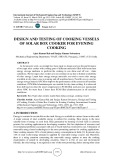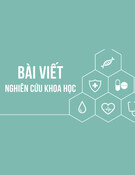
http://www.iaeme.com/IJMET/index.asp 1931 editor@iaeme.com
International Journal of Mechanical Engineering and Technology (IJMET)
Volume 10, Issue 03, March 2019, pp.1931-1938. Article ID: IJMET_10_04_196
Available online at http://www.iaeme.com/ijmet/issues.asp?JType=IJMET&VType=10&IType=3
ISSN Print: 0976-6340 and ISSN Online: 0976-6359
© IAEME Publication Scopus Indexed
DESIGN AND TESTING OF COOKING VESSELS
OF SOLAR BOX COOKER FOR EVENING
COOKING
Ajeet Kumar Rai and Sanjay Kumar Srivastava
Mechanical Engineering Department, VIAET, SHUATS, Prayagraj, 211007, (U.P.) India
ABSTRACT
In the present work, an attempt has been made to design and test the performance
of box type solar cooker with cooking pots of different materials filled with latent heat
energy storage mediums to perform the cooking in sun shine and off sun - shine
conditions. The box type solar cookers are not common in use due to limited availability
of solar energy. Latent heat energy storage materials are used to store solar energy
available in day time to use in evening and off sunshine hours. Paraffin wax is used as
energy storage material (PCM) to improve the performance of the system in off sunshine
conditions. PCM filled aluminium pots are suitable for day time cooking. It is observed
from full load test that the water temperature in PCM filled steel pots are maintained
above 950C for more than 3 hours than PCM filled aluminium pots in off sunshine
conditions.
Keywords: Box Type solar cooker, Latent heat energy storage, cooking vessel.
Cite this Article: Ajeet Kumar Rai and Sanjay Kumar Srivastava, Design and Testing
of Cooking Vessels of Solar Box Cooker for Evening Cooking, International Journal
of Mechanical Engineering and Technology, 10(3), 2019, pp. 1931-1938.
http://www.iaeme.com/IJMET/issues.asp?JType=IJMET&VType=10&IType=3
1. INTRODUCTION
Energy is essential to sustain life on the earth. Energy is available in various forms on the earth.
A major amount of total available energy is utilized for cooking. Heat energy is the most
suitable form of energy to cook food. Heat generation by burning of fossil fuels is common
practice for cooking applications in developing countries. But fast depletion of resources and
environmental problems associated with use of fossil fuels has restricted its use. Utilization of
renewable energy based technologies is the most promising options for cooking applications.
Since cooking requires 36% of total primary energy consumptions in India [1]. In present days
14% of total world energy demand is supplied by renewable energy sources [2]. Therefore,
there is a rising attention concerning the renewable energy options to meet the cooking
requirements of people in developing countries. Since it is free of cost and environment
friendly, the solar energy is recognized as one of the most promising choice among other clean





















